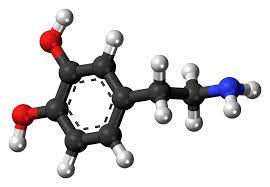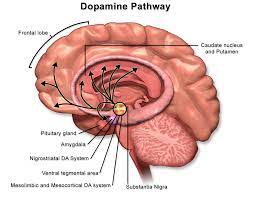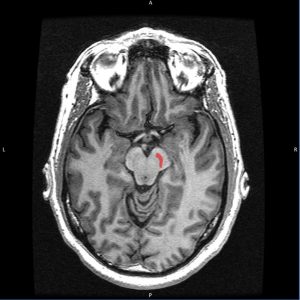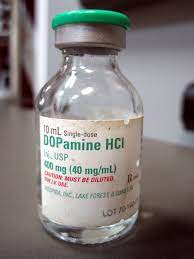Dopamine Hormone Guide
Dopamine is a hormone that serves many complex purposes throughout the body, although it is most well-known for its impact on reward and addiction. Dopamine belongs to both the phenethylamine and catecholamine families.
Drugs from the phenethylamine family are known for their stimulant effects and their psychoactive effects. Catecholamines are hormones that alter the overall activity level of the central nervous system.
How Did Dopamine Get Its Name?
Dopamine gets its name directly from its chemical structure. Dopamine is an amine, meaning that it is a nitrogen-based organic molecule. Dopamine is  formed when an L-DOPA molecule loses its carboxyl group.
formed when an L-DOPA molecule loses its carboxyl group.
Dopamine is active both in the brain and in the body's peripheral systems, but Dopamine acts independently as released in both contained systems.
What is the Function of Dopamine in the Brain?
Dopamine is a hormone that sends messages to other brain parts, also known as a neurotransmitter. A number of areas of the brain are activated by Dopamine, most notably, the area associated with desire and reward. Still, the hormone is also associated with a wide variety of other physiological actions.
The majority of things we, as humans, find rewarding—delicious food, sex, drugs—cause this dopamine-based reward system to be activated. Things that are addictive can fire off these pleasure centers to an extent where the body and mind begin to crave further stimulation.
Dopamine is also related to other activities in the brain, however. It stimulates the release of other hormones, and it helps control movement. Several neurological motor disorders are associated with Dopamine dysfunction, including Parkinson's disease.
Parkinson's disease is a neurological, degenerative condition that causes the body to shake near-uncontrollably while slowly leading to immobility over time. Parkinson's is caused when the substantia nigra no longer produces Dopamine which helps regulate motor activity.
Although Parkinson's is a chronic, degenerative disorder, it can be treated with drugs that increase the concentration of Dopamine in the brain. These drugs are also known as antipsychotics.
Other conditions which are hypothesized to be associated with dopamine-inhibition are Restless Legs Syndrome and ADHD.
What Is the Function of Dopamine in the Human Body?
Dopamine is highly active in the brain, but it also serves a number of purposes in the peripheral systems of the body, where it acts as a hormonal messenger.
In the cardiovascular system, dopamine blocks the release of norepinephrine, causing the blood vessels to open up.
In the renal system, the hormone encourages urination and the evacuation of sodium.
Dopamine inhibits the production of insulin by the pancreas
In the gastrointestinal system, Dopamine slows down the rate at which foods pass through the system and helps protect the lining of the intestines.

In the immune system, Dopamine slows down the activity of white blood cells.
Aside from the cardiovascular system, all peripheral effects of Dopamine are considered paracrine activity—this means that Dopamine is released near where it is absorbed by nearby cells, exerting its influence.
How do Medications Affect the Release of Dopamine?
Because of the hormone's importance, a variety of drugs are available which affect how the body secretes or utilizes Dopamine. Bio-Identical Dopamine Injections are a common form of treatment, but when administered intravenously, dopamine is incapable of passing through the blood-brain barrier. Dopamine is frequently used as an emergency treatment for patients suffering from shock or heart failure.
Because there is no way to deliver Dopamine to the brain directly, the most effective way to increase Dopamine levels via medication is through the Dopamine precursor, L-DOPA.
L-DOPA can pass through the blood-brain barrier and is one of the most common treatments for Parkinson's because it can suppress tremors by providing Dopamine to struggling areas of the brain.
Drugs which stimulate Dopamine are almost always addictive in high quantities, but they are effective at modest doses to alleviate ADHD. Antipsychotics, on the other hand, are medications that suppress the activity of Dopamine in the body. Similar drugs suppress Dopamine through other means that are highly effective at treating nausea.
Dopamine and the Brain
The brain area central to the body's physiological reward system is located in the ventral tegmental area, and nerves in this region secrete dopamine in response to or in preparation for reward. After Dopamine is produced, it travels to the prefrontal cortex and the nucleus accumbens.
Dopamine also controls motor ability but does so through a different mechanism that does not interact directly with the pleasure pathway. To help control movement, Dopamine is released by neurons in the substantia nigra, and the hormone travels to the striatum.
The striatum is responsible for our mind's ability to control our movements, and it also allows for fine motor function by suppressing the body's minor conscious movements to enhance control. It also plays a role in social inhibition.
Dopamine Transmitters
Dopamine is a hormone that plays a wide variety of roles. It is a reward mechanism; it stimulates cognition, motivation, arousal, and physical self-control. There are a number of automatic functions that are related to Dopamine as well, such as the sensations of nausea and sexual pleasure, as well as lactation.
Perhaps surprisingly, there aren't a whole lot of neurons in the brain that are dedicated primarily to Dopamine production. In fact, the entire brain only has about 400,000 of these neurons, and they are located in very particular areas of the brain. Despite their small number, they have a widespread impact on physiological function.
Areas of the Brain Which Release Dopamine
The Substantia Nigra - Dopamine and Fine Motor Control
As we mentioned earlier, Dopamine plays a vital role in the body's ability to control its movements. Dopamine exerts control over motor function through the substantia nigra, an area of dark brain tissue attached to the basal ganglia.
Most of the Dopamine neurons in the substantia nigra are located in an area known as the pars compacta.
The cells emitting dopamine in this area can become damaged relatively quickly. If a large portion of these cells dies, it brings about symptoms that are  very similar to Parkinson's Disease.
very similar to Parkinson's Disease.
The Ventral Tegmental Area - Dopamine, Motivation, and Reward
Another area of the brain with dense Dopamine activity is the ventral tegmental area. This area of the brain is responsible for providing the psyche with motivation.
Researchers have noted that Dopamine's actions in the ventral tegmental area affect psychological motivation in a similar manner that the nucleus accumbens affects the fine control of motor activity.
This means that the ventral tegmental area is also responsible for controlling acceptable cognitive activity as well, including the mind's ability to make decisions.
Dopamine and the Hypothalamus
Some cells produce Dopamine which is located in the posterior hypothalamus and extends into the spinal cord. Still, medical researchers are unsure how Dopamine impacts the body through this route.
Evidence supports the hypothesis that this Dopamine pathway controls the suppression of motor movement in the body, and those with Restless Legs Syndrome suffer from Dopamine Deficiency in this area of the brain. Restless Legs Syndrome makes it hard to sleep, resulting from the body's unconscious movements, which are most severe in the legs.
Dopamine and Lactation
Dopamine Neurons in the Periventricular Nucleus and the Arcuate Nucleus suppress the release of breast milk, which is encouraged through the release of prolactin. Dopamine produced in this part of the brain flows into the pituitary gland.
The body produces Dopamine to prevent lactation, and when mothers prepare to nurse, this pathway suppresses the production of Dopamine, which allows lactation to occur.
When discussed in the context of this system, Dopamine is often referred to by other names, including Prolactostatin, Prolactin-Inhibiting Hormone, or Prolactin-Inhibiting Factor.
Dopamine, Puberty, and Sex Hormone Production
This area of the brain is tightly interconnected with the Hypothalamus. For the body to produce sex hormones, Dopamine is released from the Zona Incerta into the Hypothalamus, where the hormone encourages the production of Gonadotropin-Releasing Hormone.
The number of Dopamine Receptors in the brain increases dramatically during this period, which helps encourage the rapid onset of sexual changes associated with puberty.
Dopamine and Eyesight
Dopamine also plays a role in eyesight. During the day, amacrine cells in the retina produce Dopamine, which simultaneously increases cone cells' receptivity while reducing rods' influence. This mechanism makes it easier to see during the day. At night, Dopamine production in this area declines, making it easier to see in dim light.
Dopamine Activity In the Body
As dopamine cannot cross from the bloodstream into the brain, any dopamine produced by the body's peripheral systems has no direct impact on Dopamine activity within the brain.
A lot of dopamine travels through the circulatory system, but researchers are still learning how Dopamine impacts the body's physiology via this pathway.
Some Dopamine is absorbed through the diet, but the body converts this Dopamine into a different form that researchers have discovered no use for. This form of Dopamine is eventually released after the kidneys filter it out.
It is believed that an active form of Dopamine is produced by specific organs, including those in the digestive and sympathetic nervous systems. Physiologically active Dopamine can go through a number of processes in the body.
The adrenal glands sometimes convert it into norepinephrine, an important hormone that regulates fight-or-flight mechanisms. It can also activate receptor sites throughout the body or can simply be metabolized.
There are numerous receptors for Dopamine in the arteries. Dopamine activity in this area suppresses the production of norepinephrine and opens up the arteries.
Dopamine and the Immune System
Dopamine has a powerful effect on the immune system, especially on the circulatory system, bone marrow, and spleen. Also, Dopamine suppresses the activity of white blood cells. Cells in the immune system can release Dopamine, so it is believed that Dopamine helps prevent the white blood cells from going into overdrive.
Dopamine and the Renal System
There are a number of locations in the kidneys that react with Dopamine, and the kidneys actually produce Dopamine by tubule cells. Dopamine serves a number of purposes in this system.
It encourages filtration, helps draw sodium from the bloodstream, and enhances blood flow to the organ. If the kidneys lose their ability to produce Dopamine effectively, this can lead to issues such as hypertension and elevated sodium levels.
Dopamine and the Pancreas
Dopamine plays an intricate role in the function of the pancreas. The pancreas has two sections, the endocrine area, and the exocrine area. The exocrine section of the pancreas helps control digestion, releasing substances such as enzymes into the digestive tract to help break down and absorb food. Dopamine plays a role in this process, although researchers are not entirely sure of its function.
food. Dopamine plays a role in this process, although researchers are not entirely sure of its function.
Researchers hypothesize that Dopamine slows down the rate at which the body processes food and preserves the inner lining of the intestines.
The areas of the pancreas which regulate internal health are known as the islets of Langerhans. This area is responsible for producing hormones released into the bloodstream, one of which is insulin.
The cells within the islets of Langerhans which produce insulin are known as beta cells. These cells are believed to be receptive to the influence of Dopamine and that Dopamine activation suppresses insulin production.
Dopamine and Risk
There is a strong correlation between Dopamine levels in the brain and one's desire and ability to take risks. Individuals with lower levels of Dopamine activity in the brain tend to be more cautious and are less likely to seek out risk. In contrast, individuals with high levels of natural Dopamine production are more likely to enjoy and thrive on risk.
Dopamine is the reason why, when we do something that takes effort and risk, it elicits a feeling of satisfaction. Dopamine encourages us to go outside our comfort zone and do things we usually wouldn't do.
It causes one to thrive on risk, experiencing a literal high when they meet their goals. This often causes them to seek out larger and larger risks, as their surmounted risks are no longer as exciting.
The difference in Dopamine levels among different groups of people explains why some people are happy with comfortable lives and are risk averse, while others seem to thrive on the sensations associated with risk.
Part of what controls Dopamine activity in the brain is the existence of what is known as autoreceptors. Autoreceptors bind with Dopamine and reduce their activity in the body.
Researchers have found that people that enjoy risk have fewer of these Dopamine inhibitors, which causes them to be more interested in engaging in risk-taking.
Many people are addicted to Adrenaline. This sensation happens when we ride roller coasters or get in dangerous situations. Adrenaline rewards risky behaviors, but it doesn't reward stepping out of one's comfort zone necessarily. Whereas Adrenaline makes people love driving fast and getting into fights, Dopamine makes people want to engage in pursuits that might deter others.
Dopamine doesn't engage the fight-or-flight response; it simply causes a person to downplay risks and be more likely to engage in out-of-the-box activities.
Dopamine and Depression
Dopamine deficiency is associated with an increased incidence of depression. Robin Williams's recent passing is perhaps a testament to this connection. After Robin Williams committed suicide, it was revealed by his wife that Robin was struggling with the initial stages of Parkinson's disease.
As we've discussed, Parkinson's is a medical disorder caused when the brain's motor area no longer produces enough Dopamine to regulate motor movement, leading to the tremors and shaking associated with the disorder.
Reduced Dopamine levels also can lead to depression because the brain's reward system is not as active. The body and mind simply do not experience pleasure in the same way, increasing the likelihood of depression.
In Williams' case, depression led him to suicide.
Dopamine also controls one's sense of motivation. In many cases, when people genuinely want to do something but can't generate willpower, this results from Dopamine Deficiency.
Parkinson's Disease and Depression are independent disorders, but one is more likely to occur when the other is present. The conditions also play off of each other and can worsen the effects of both for the patient. The combination leads to feelings of intense isolation and anxiety, which can be incredibly difficult to overcome.
References:
Dopamine Wiki:
http://en.wikipedia.org/wiki/Dopamine
The Mystery of Risk:
http://ngm.nationalgeographic.com/2013/06/125-risk-takers/gwin-text
Dopamine Regulates Motivation to Act, Study Shows:
http://www.sciencedaily.com/releases/2013/01/130110094415.htm
- What Is Adrenal Fatigue [Last Updated On: August 21st, 2023] [Originally Added On: October 23rd, 2020]
- Understanding Thyroid Function And Diagnosing Thyroid Issues [Last Updated On: August 21st, 2023] [Originally Added On: October 24th, 2020]
- Twelve Steps To Enhance And Preserve Your Memory [Last Updated On: February 21st, 2024] [Originally Added On: October 25th, 2020]
- The Psychological And Physiological Effects Of Serotonin [Last Updated On: February 20th, 2024] [Originally Added On: October 26th, 2020]
- The Facts About Psoriasis: Symptoms And Causes [Last Updated On: February 19th, 2024] [Originally Added On: October 27th, 2020]
- The Facts About Acromegaly [Last Updated On: August 21st, 2023] [Originally Added On: October 28th, 2020]
- The Effects Of Hgh Deficiency Upon One Of A Pair Of Twins [Last Updated On: February 18th, 2024] [Originally Added On: October 29th, 2020]
- Resveratrol Anti-aging Supplementation For Longevity [Last Updated On: August 21st, 2023] [Originally Added On: October 30th, 2020]
- Sermorelin Acetate Injections With Ghrp-6 [Last Updated On: October 31st, 2022] [Originally Added On: October 31st, 2020]
- Melatonin The Sleep Hormone How It Impacts Your Health [Last Updated On: August 21st, 2023] [Originally Added On: November 1st, 2020]
- Mark Cuban To Fund Study On Healing Power Of Hgh [Last Updated On: August 21st, 2023] [Originally Added On: November 2nd, 2020]
- Mark Cuban Advocates For Hgh As A Rehab And Recovery Tool [Last Updated On: February 17th, 2024] [Originally Added On: November 3rd, 2020]
- Leptin Hormone Guide: The Effects Of The Satiety Hormone [Last Updated On: February 16th, 2024] [Originally Added On: November 4th, 2020]
- Human Growth Hormone Deficiency Impact On Sleeping Habits [Last Updated On: February 15th, 2024] [Originally Added On: November 5th, 2020]
- Human Growth Hormone And Liver Regeneration [Last Updated On: February 14th, 2024] [Originally Added On: November 6th, 2020]
- Hgh Treatment For Fatty Liver Disease On The Horizon [Last Updated On: September 14th, 2022] [Originally Added On: November 7th, 2020]
- Your Current HGH Level [Last Updated On: February 23rd, 2023] [Originally Added On: November 8th, 2020]
- Ghrelin The Hunger Hormone [Last Updated On: February 13th, 2024] [Originally Added On: November 9th, 2020]
- Enclomiphene Citrate Andropause Treatment Up For Fda Approval [Last Updated On: February 12th, 2024] [Originally Added On: November 10th, 2020]
- Diabetes Cure On The Horizon [Last Updated On: February 11th, 2024] [Originally Added On: November 12th, 2020]
- Boost Metabolism To Lose Weight And Maintain Weight Loss [Last Updated On: February 10th, 2024] [Originally Added On: November 13th, 2020]
- Andropause A Mid-life Hormone Crisis [Last Updated On: November 10th, 2022] [Originally Added On: November 14th, 2020]
- SOGROYA INJECTIONS FOR HUMAN GROWTH HORMONE DEFICIENCY [Last Updated On: January 21st, 2023] [Originally Added On: March 24th, 2021]
- How Do High and Low Estrogen Impact Male Health and Wellness? [Last Updated On: March 1st, 2024] [Originally Added On: April 2nd, 2021]
- The Effects Of Hormone Imbalance On Belly Fat [Last Updated On: September 14th, 2022] [Originally Added On: May 8th, 2021]
- Could Sunlight Help Remove Rogue Hormones from the Water Supply? [Last Updated On: January 25th, 2023] [Originally Added On: May 29th, 2021]
- Weekly HGH Therapy Just as Effective as Daily Injections [Last Updated On: February 26th, 2023] [Originally Added On: June 18th, 2021]
- DHEA and Testosterone: A winning team! [Last Updated On: April 6th, 2024] [Originally Added On: January 19th, 2022]
- Animal Research Discovers Link Between Exercise, HGH, and Cognitive Ability [Last Updated On: April 6th, 2024] [Originally Added On: May 20th, 2022]
- Weekly Hormone Treatments for Adult HGH Deficiency with Sogroya [Last Updated On: November 30th, 2022] [Originally Added On: June 14th, 2022]
- Ancient Critters Made Human Hormone System What It Is Today [Last Updated On: February 14th, 2023] [Originally Added On: June 26th, 2022]
- How Substance Abuse Can Affect Your Hormone Levels [Last Updated On: February 21st, 2023] [Originally Added On: August 4th, 2022]
Word Count: 2407







